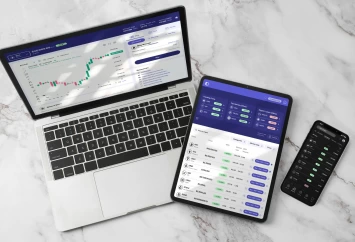Embarking on your cryptocurrency journey begins with a pivotal choice: selecting the right crypto exchange. These exchanges are vital, enabling you to buy, sell, and trade cryptocurrencies like Bitcoin and numerous altcoins. They’re your entry into the exciting, yet unpredictable crypto trading realm, offering more than just transaction services.
Exchanges provide advanced trading tools, secure storage, educational resources, and customer support. These features are essential for traders at any level of experience.
For newcomers, the vast array of crypto exchanges might seem daunting. Each platform comes with its own set of features, benefits, and limitations.
Among the plethora of options, Binance and Coinbase stand out for their popularity and reliability in the crypto community. Each serves different user needs and preferences. This article offers a comprehensive comparison of Binance and Coinbase, guiding beginners through choosing the most suitable platform for their cryptocurrency trading ventures.
Overview of Binance and Coinbase
Binance at a Glance
Binance stands as a titan among centralized cryptocurrency exchanges worldwide. Launched in 2017 by visionaries Changpeng Zhao (CZ) and Yi He, it has swiftly grown to support over 180 countries and boasts a user base exceeding 90 million. Known for its broad spectrum of offerings, Binance provides access to more than 350 cryptocurrency assets and upwards of 1,300 trading pairs.
Its diverse trading options include spot, margin, futures, and peer-to-peer (P2P) trading, catering to a wide range of trading preferences. Binance enhances user convenience with a variety of payment methods such as direct bank deposits, debit/credit cards, and even Apple Pay and Google Pay. The platform’s native currency, Binance Coin (BNB), entices users with trading fee discounts. Beyond trading, Binance enriches its ecosystem with an NFT marketplace, a Web3 wallet, and the Binance Earn program for passive income opportunities.
Coinbase at a Glance
Coinbase, a cornerstone in the cryptocurrency exchange domain, is celebrated for its straightforward interface and stringent security protocols. Founded on the principle of democratizing access to cryptocurrencies, it offers a seamless experience for buying, selling, and storing digital currencies like Bitcoin and Ethereum.
Its design is particularly user-friendly, making it a favorite among novices, complemented by an array of educational materials. Coinbase ensures secure transactions with features like two-factor authentication, biometric logins, and cold storage for the bulk of customer assets. Adherence to various regulatory standards further cements its reputation as a trusted platform.
For traders seeking more depth, Coinbase provides an advanced trading dashboard, equipped with real-time market data, interactive charts, and a comprehensive set of market indicators, courtesy of its collaboration with TradingView.
User Experience and Interface
Interface Simplicity
The user interface plays a pivotal role in the choice between Binance and Coinbase, influencing the user experience profoundly. Coinbase has earned accolades for its straightforward and user-centric design. Its interface is neat, intuitive, and simplifies navigation, making it perfect for novices.
The design is uncluttered, featuring clear directions and an easy-to-understand dashboard that displays your portfolio, cryptocurrency prices, and recent transactions. This design simplicity ensures that newcomers can easily learn the essentials of purchasing, selling, and managing their cryptocurrencies without feeling swamped.
On the other hand, Binance presents a more intricate and feature-dense interface. This complexity can serve advanced traders well, offering them an array of tools and features, but it might intimidate beginners. Binance does offer a “Lite” version designed for new users, which distills the interface to its most fundamental features.
Nevertheless, the comprehensive version of Binance includes detailed charts, various order types, and options for margin and futures trading, which might take some time for users to fully adapt to.
User Learning Curve
The learning curve is an important consideration when comparing the user experience of these platforms. Coinbase caters to beginners, effectively flattening the learning curve. Its simplicity and clear navigation allow users to quickly dive into trading and managing their cryptocurrencies without requiring extensive background knowledge.
Additionally, educational tools like the Coinbase Earn program, which rewards users for learning about different cryptocurrencies, further enrich the learning journey.
Conversely, Binance’s wide range of features and advanced trading capabilities result in a steeper learning curve. While experienced traders might value the platform’s extensive functionalities, newcomers could find it daunting. Binance tries to alleviate this with the Binance Academy, offering tutorials and guides on advanced trading concepts.
Despite these resources, new users might still need considerable time and effort to familiarize themselves with all the features Binance has to offer.
Security and Customer Support

Security Measures
When it comes to security, both Binance and Coinbase employ robust measures to protect user assets, with some differences in their approaches. Coinbase is renowned for its stringent security protocols, including AES-256 encryption for data at rest and in transit. This high encryption standard ensures user information and financial transactions are secure from unauthorized access. Moreover, Coinbase stores about 98% of its users’ cryptocurrency assets in cold storage, greatly reducing hacking risks since these assets are offline.
Coinbase enhances account security with two-factor authentication (2FA) and biometric verification. Its hot wallets, holding a minor percentage of online assets, are insured, adding an extra protection layer against theft. Additionally, Coinbase strictly adheres to regulatory compliance, following Know Your Customer (KYC) and Anti-Money Laundering (AML) regulations to prevent fraud and illegal activities.
Despite past security breaches, such as the 2019 incident where $40 million was stolen, Binance has strengthened its security with multi-factor authentication (MFA), withdrawal whitelists, and AI-driven risk management. The platform also has a Secure Asset Fund for Users (SAFU) with a $1 billion reserve to compensate users in extreme security events. Binance.US, catering to American users, provides FDIC insurance for USD balances, enhancing security further.
Customer Service
The quality of customer support is an important consideration when choosing between Binance and Coinbase. Coinbase is often commended for its comprehensive and accessible customer support, offering a detailed FAQ section, email, phone, and live chat support. It also provides educational resources and a user-friendly interface for navigating common issues. However, some users have reported challenges in receiving timely and effective support, especially during high demand or complex issues.
Conversely, Binance’s customer service reputation is mixed. Despite offering extensive support resources, such as a FAQ section, email support, and live chat, some users have experienced delays and difficulties in resolving their issues. Binance’s global presence means it serves a diverse user base, sometimes leading to inconsistencies in support quality. Nevertheless, Binance is actively working to enhance its customer support by expanding its team and improving its support infrastructure.
Conclusion
In sum, choosing between Binance and Coinbase hinges on your trading background, specific requirements, and personal preferences. For those new to the scene, Coinbase shines with its intuitive design, straightforward approach, and stringent adherence to regulations, presenting a solid foundation for newcomers. It boasts a carefully selected array of both well-established and emerging cryptocurrencies, alongside formidable security protocols, ensuring a secure and user-friendly platform.
Conversely, Binance caters to the seasoned trader, offering an extensive selection of over 350 cryptocurrencies, reduced transaction fees, and a broad spectrum of services including derivatives, NFTs, and its Earn program. This makes it a superior choice for those seeking a comprehensive and sophisticated trading experience.
When making your decision, weigh aspects like the diversity of cryptocurrencies on offer, interface complexity, security safeguards, and the quality of customer support. Whether you lean towards Coinbase for its simplicity and regulatory robustness or Binance for its advanced functionalities and extensive options, it’s imperative to align your choice with your investment objectives and trading prerequisites.
Allocate time to investigate both platforms thoroughly, and feel empowered to embark on your cryptocurrency venture today.
For more options beyond these two platforms, see our complete our guide to cryptocurrency exchanges.
FAQ
Which cryptocurrency exchange is more user-friendly for beginners, Binance or Coinbase?
Coinbase stands out as the more user-friendly option for beginners, thanks to its straightforward, sleek interface, easy navigation, and clear instructions, making it the go-to choice for those new to the crypto world.
How do the fees compare between Binance and Coinbase, and which is more cost-effective for new traders?
When it comes to fees, Binance offers a more cost-effective solution with its lower fee structure of 0.1% for spot trading. This can be further reduced by using BNB tokens and engaging in high-volume trading. In contrast, Coinbase’s fees range between 0.4% and 0.6% for both makers and takers, positioning Binance as the more affordable option for new traders.
What are the key differences in the security features and regulatory compliance between Binance and Coinbase?
Significant differences can be observed in:
– Security: Coinbase boasts a strong security record, with no history of hacks, utilizing cold storage, biometric access controls, and insurance to protect user assets. Binance, despite previous security breaches, has strengthened its security measures with two-step verification, device management, and a substantial $1 billion Secure Asset Fund for enhanced protection.
– Regulatory Compliance: Coinbase is recognized for its stringent adherence to U.S. regulations, making it compliant and available across all 50 states. Binance, on the other hand, has encountered regulatory challenges and is not accessible in every U.S. state. However, it is making strides in expanding its compliance team and meeting global regulatory standards.
Can US citizens use the global Binance platform, or do they need to use Binance.US, and what are the limitations of Binance.US?
Due to regulatory constraints, US citizens are restricted from using the global Binance platform and must instead use Binance.US. This alternative offers a more limited experience, featuring fewer cryptocurrencies (approximately 85 compared to the global platform’s 395), no support for futures trading or debit/credit card purchases and withdrawals, and higher fees for bank withdrawals. Additionally, Binance.US is not available in several states, including New York, Texas, Louisiana, Hawaii, Idaho, and Vermont.


